Favignana: “No. 13 Clearest Water in the World” tantalizes sun worshippers off Sicily’s west coast

FAVIGNANA, Italy — I’m a sucker for world lists. The World’s Most Beautiful Mountains. The World’s Most Dangerous Highways. The World’s Best Restaurants. Facebook is filled with them every day. Being a water person, one list from Weather.com made me stand up and look at my sunscreen supply: The World’s Clearest, Bluest Water.
I’m a scuba diver so water clarity is huge for me. Visibility is as important as water temperature. The water off Cozumel in the early ‘80s was so clear I could see a wall 100 meters from the one I was swimming along. The turquoise water in French Polynesia made it hard to differentiate the South Pacific from the sky.
Who knew that I could add to my list of aqua paradises by traveling only two hours from Rome?

Yes, there it was, No. 13 on The Weather Channel’s 2016 list: Favignana, more specifically, Cala Azzurra beach. I’d never heard of Favignana, either. It’s a small island off the west coast of Sicily sporting a name it took me a month to remember. My girlfriend, Marina Pascucci, is an ace photographer whose whole profession is based on clarity. She’d been to Favignana (pronounced fa-vin-YAH-nah) before and wanted to take me to another special place for my birthday. Last year it was Syracuse, Sicily. This year, we’d go back to Sicily. One more trip and I’ll be paying off politicians.
WEATER.COM’S TOP 15
1. The Cook Islands
2. Cocos Island, Costa Rica
3. Knip Beach, Curacao
4. Five-Flower Lake, China
5. Maldives
6. Koh Lipe, Thailand
7. Jaco Island, East Timor
8. Marsa Matrouh, Egypt
9. Boracay, Philippines
10. Virgin Gorda, British Virgin Islands
11. Los Roques, Venezuela
12. Lefkada, Greece
13. Cala Azzurra, Favignana, Italy
14. Havelock Island, Andaman Islands
15. To Sua Ocean Trench, Samoa
I’m sorry. That’s a crude stereotype of a Sicily that I have long since forgotten. Sicily has the best food in Italy, spectacular beaches, friendly people, fascinating history and, as I’d learn, some of the clearest waters in the world. Also, spring in Sicily is an almost ideal time to go. The warm weather has arrived before the waves of tourists. Prices are lower and there’s no need to wait in line for a cannoli.

I not only didn’t know anything about Favignana, I didn’t know how easy it is to reach. It’s a 1-hour, 10-minute RyanAir flight from Rome to Trapani, then a 30-minute ferry ride to Favignana four miles away. That’s it. In Italy it takes longer to buy a stamp.
Giuseppe “Jose” Tammaro, the 72-year-old owner of our Isola Mia hotel, met us at Favignana’s postcard-cute harbor. Sporting long, shocking white hair and shades, he looked like a movie director specializing in exotic locales. Or he could pass as an aging musician which he somewhat is. His folk music band, formed 15 years ago, is called Macuccusonu. A Favignana native who spends the winters in Northern Italian, he drove us the five minutes to Isola Mia, a series of one-story adobe-style bungalows connected with red-tiled roofs surrounding palm and Mediterranean pine trees. It’s like a small ranch in Arizona. Our room had a TV, refrigerator and space out back where we could eat our breakfast and stare out at the island countryside. Iose apologized for all the dirt in the courtyard. They were planting grass for the summer season. We barely noticed. It was as peaceful and quiet as anywhere we’ve been in Italy.

Favignana, the largest of the three Egadi islands, is only 14 square miles and shaped like a butterfly. The port and village form the head, with narrow roads snaking into the eastern peninsula and the more rural tracks in the larger western side featuring forests and grottoes .
A former Phoenician outpost during the Punic Wars of the 3rd century B.C., Favignana was where the Roman navy destroyed 120 Carthaginian ships in 241 BC. So many Phoenicians washed ashore that they called the beach forevermore, “Cala Rossa” (Red Cove). In truth, it was named for the beach’s red clay but the Roman military preferred its explanation for PR purposes.
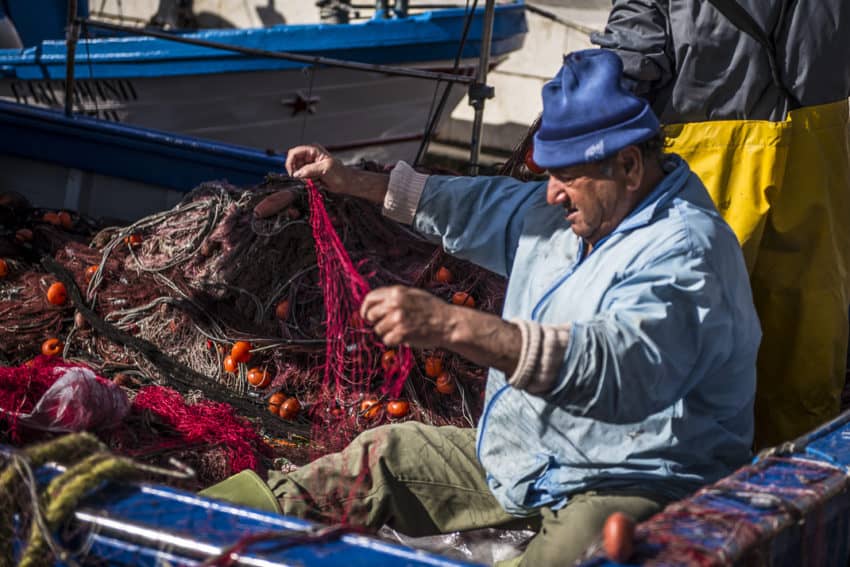
Since then, Favignana has been ruled by the Arabs, Normans, Aragonese and Spanish who discovered the waters had enough tuna for tapas from Madrid to Tierra del Fuego. The tuna industry ruled until declining in the 20th century. Taking over in the 1960s was tourism.
Not many come in spring. Water temperature is about 52 degrees, too cold for anything more than your more adventurous fur seals. Forget Italians. They don’t drink water 52 degrees. The time to come is the fall. The tourists have left but the warm waters, heated by Sicily’s steaming summer, are still around.
So Marina and I wandered the five minutes from Isola Mia through the narrow alleys lined with alabaster white apartments, tiny vegetable markets and cozy local trattorias. Near the harbor is a crude beach with some rusted boats behind a Cyclone fence. An old man played with his two dogs as we gazed at an apartment house with two balconies overlooking the sea. Near the harbor, the sea had the color of cobalt. We were told to get on a bike and explore to see the turquoise of tourist posters.
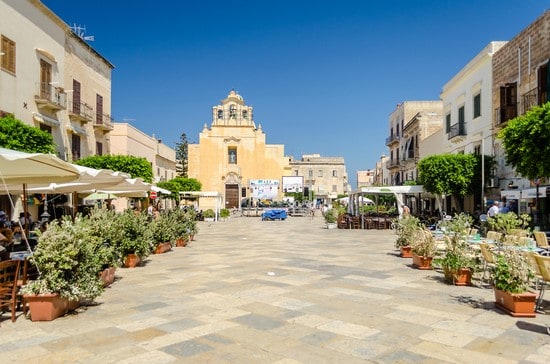
All the paths seem to lead to Piazza Madrice, a long courtyard anchored by the 18th-century Chiesa Madre Maria SS Immacolata on one end. On the corner is the nerve center of Favignana. Caffe Aegus serves some great pistachio gelato in town and a nice Nero d’Avalo, Sicily’s signature ruby-red wine. But you come here for the local rundown. It’s the perfect cross-section view of the island. As we settled into our seats, an old woman dressed in all black shuffled past us. Middle-aged men in street clothes played soccer on the cobblestones with surprising flair. Bells pealed from the church.
Next to our table sat an old man in a classic Sicilian fishing cap, the kind with the top squished down and pinned to the bill and what Marina once gave me. He hailed from Frosinone, a downtrodden town 55 miles south of Rome. He’s been in Favignana 42 years and lauded its famed scuba diving and snorkeling. I asked him about the stories of overfishing and he scoffed.
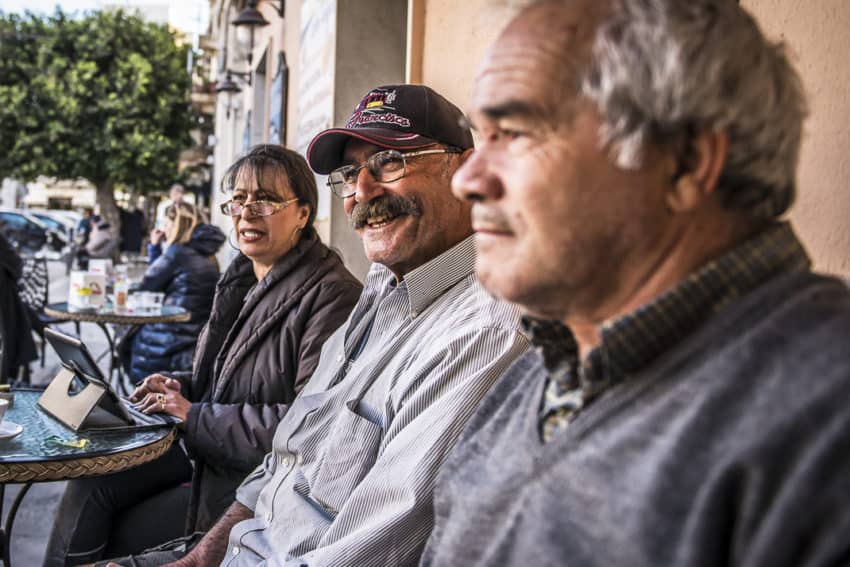
“No, there are more fish,” he said then gave me the single fist bump, the international hand signal of, ahem, procreation.
Like everywhere else in Sicily, fish is all over the menus here. Iose recommended Trattoria da Papu’. The fish theme overwhelmed us as we walked in to walls draped in fishnets, anchors, starfish, black and white photos of old fishermen and a gorgeous sunset photo from the 1980s.

Multiple trips to Sicily have changed my perspective on Italian food. Sicily shot right past Emilia-Romagna as the top region. The large variety of seafood is so fresh and the desserts — the cannoli, the granitas — are perfect for the hot Sicilian climate. And every trip I discover something new. At Papu’ I discovered busiate, a thick, twisty pasta that’s specialty to western Sicily. It’s perfect with my dish, Busiate al Profumo di Mare, busiate covered in shrimp, clams and bread crumbs. With a tuna and fried shrimp cocktail, that was all of 23 euros and a half-liter of house Nero d’Avalo was 6. You do the math.
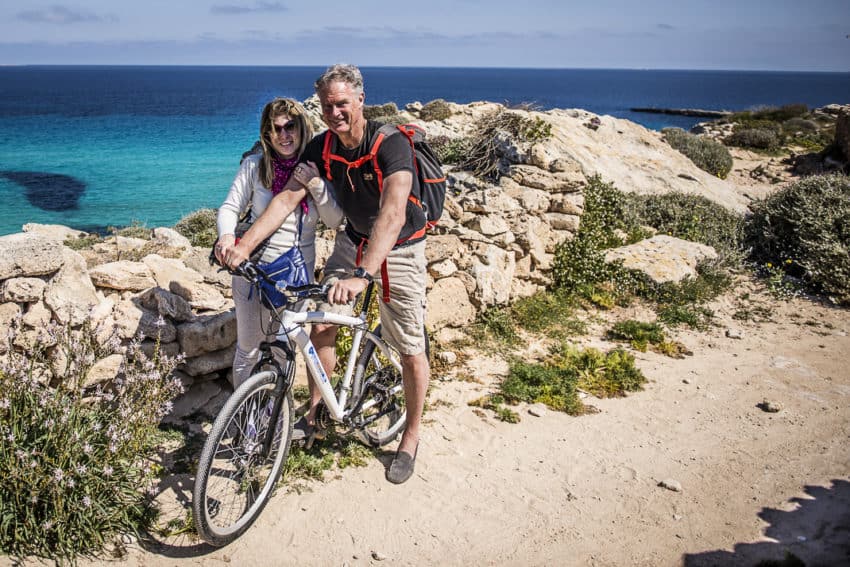
The only ways to see Favignana are by boat or bike. A car is a waste of money. The island is too small for a car and you get no feel for the fresh Mediterranean breezes. And the quiet. Oh, it is so quiet on Favignana you can hear the birds’ singing almost make sense. We woke the next day and headed back to the harbor where Noleggio Ginevra had some of the nicest bikes I’ve ever rented. They’re modern hybrids with 30-plus gears and men’s and women’s versions. I’m just not comfortable enough in my manhood to ride a bike without a crossbar.
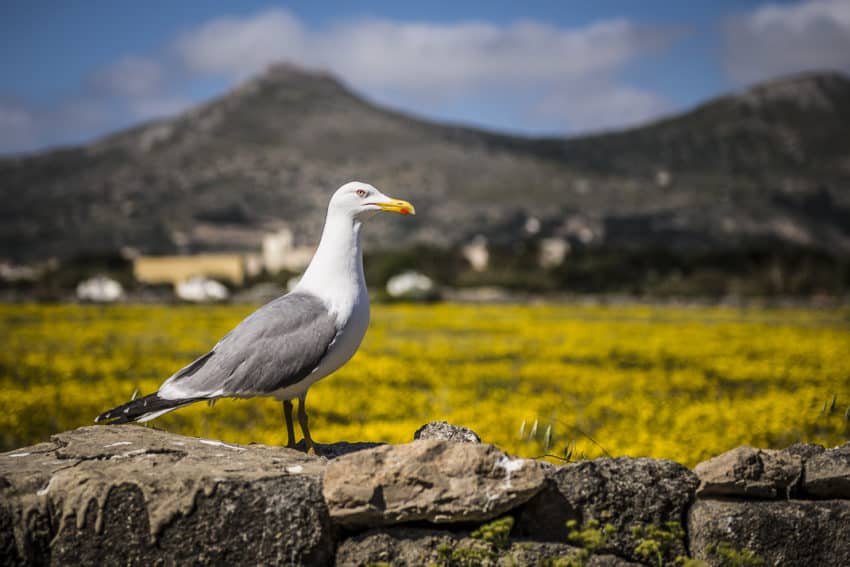
Marina and I headed along the harbor before cutting inland and going south. We passed entire fields of golden rods lined with pine and lemon and cactus trees. Stone walls bordered off excavation sites with signs reading: “Attenti al cane” (Beware of dog).
Soon, we saw our tourist poster. To our left, stretching out from the craggy beach, sat a sea so turquoise I could see the bottom from atop the cliff. It was clear as any sea I’ve ever seen, making me kick myself for not bringing a swimsuit before remembering the water temps that would sterilize me for life. We parked our bikes and walked along the rocky cliffside trail. An old man stood next to his small trailer advertising “pane cunzatu,” a traditional Sicilian sandwich featuring tomatoes, anchovies and cheese. We stared down at the 80-foot drop and wondered how crowded this corner of the Mediterranean must get in August. Then we saw a sign.
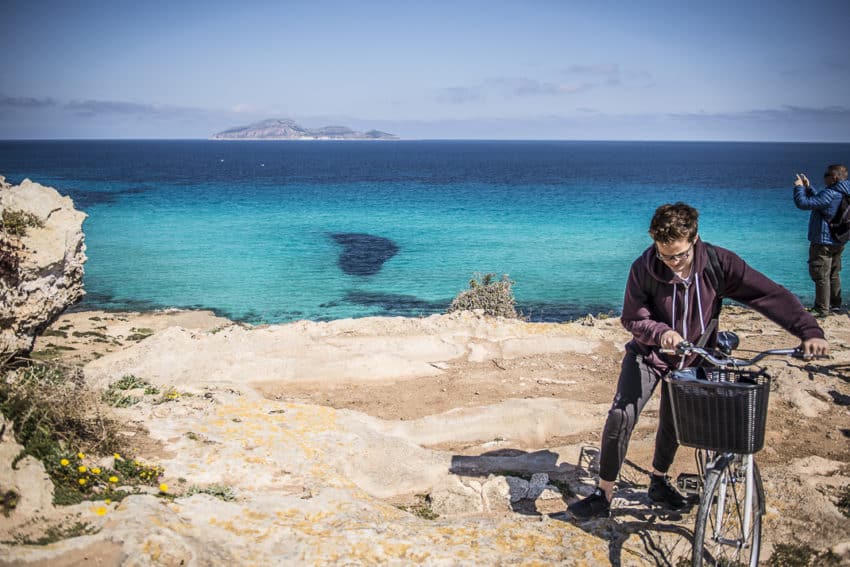
Cala Rossa.
This is where the Phoenicians met their deaths in the 3rd century B.C. and where Italians meet their nirvana in the 21st century.
The problem with Favignana is it is so small, the locals figured, Who needs signs? As we cut inland, we got as lost as anyone can on an island with nothing more than a two-lane road. Favignana has a spiderweb of small roads careening around pleasant homes and fields. Unable to find the other beaches on our checklist, we stopped a man wearing gaiters. Maybe a fisherman, maybe a gardener, maybe Favignana is infested with leeches. It didn’t matter. He was flat out crazy as a loon. I asked directions and he said, “Parli italiano?” He then gave us directions Indiana Jones couldn’t follow. Marina didn’t understand him, either and she’s Italian.
After he grabbed my arm in emphasis, I shook away and we backtracked in the general direction of his protruding finger, assuming it was his index. We eventually wound our way down to the far southern coast where we saw Cala Tuono. Seagulls joined us and a picnicking couple on the cliff as we stared down at a long beach — covered in algae. Yes, the image was somewhat stained by the sight of green squishy substance you need flip-flops to navigate in spring. Yet looking out at the turquoise sea, I’d brave the gross texture under my feet knowing the pleasure that would envelop my body in time.
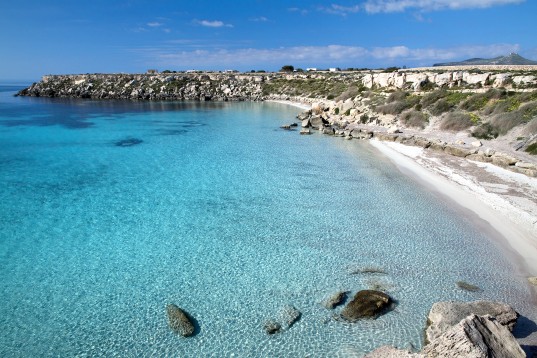
On the way back we passed a hiking group, the lone tourists we encountered on the weekend, and visited Cala Azzurra. Lined with resorts closed until summer, Cala Azzurra has a gorgeous view of 12th century Norman Fort of Santa Caterina towering over the village and beautiful turquoise swimming holes just feet from the shore.
In 15 minutes, we had pedaled back into town and parked at Paninoteca Costanza, a tiny deli with a sign featuring Wimpy, the burger-munching character from the American cartoon “Popeye,” holding a hamburger. It’s the one place on Favignana you can get a hamburger and hotdog, an unfortunately growing craze among Italian youth. We passed for the panino camparia, a fat chunk of freshly grilled tuna in a toasted sesame bun and lathered in mayo. For 6 euros, it was the best bargain in town.

I’ve long stopped asking Sicilians tired questions about the mafia and the pizzo (payoffs) and the past. Islands like Favignana are dotted all around Sicily and we plan on visiting many more.
After all, I plan on having many more birthdays.


April 21, 2017 @ 7:38 am
I love lists, too. I’ve been to Cocos Island, Virgin Gorda, and Los Roques, Venezuela. Sounds like an enchanting island.
April 22, 2017 @ 12:11 am
I’ve been to Curacao, Boracay, Virgin Gorda and now Favignana. I can’t believe the Philippines isn’t on there.
April 21, 2017 @ 1:56 pm
Favignana sounds wonderful! Interesting that the Cook Islands are #1 on the list. I was there in 1988 when it still had only 1 large ish international hotel. I’ve heard it’s totally different now and packed with resorts. Nice to see it still made best beach! Ciao, Cristina
April 22, 2017 @ 12:11 am
Thanks for the warning on Cook Islands, Cristina. I guess I’d go just to see the colors but I’d brace for the sticker shock.
April 22, 2017 @ 5:39 pm
Oh I don’t think the Cook Islands are as overdeveloped as some tropical places, it is just comparing to when I went it sounds so different. I’m sure it is still worth the visit!
April 24, 2017 @ 10:41 am
As I was reading your post, I had a good chuckle when you mentioned the frigid waters during springtime. In 2015, my husband and I spent the month of March in Italy for our honeymoon. We took a bus from Salerno to Amalfi (originally were planning to see Positano, but the scary “death bus” changed our minds, so we exited our ride in much closer, Amalfi) to visit a beach and enjoy the sea. My husband was so excited to purchase a European speedo-style swimsuit at a local boutique, I opted for something more modest! Off we went, stripping-down to our stylish swimwear to jump into the inviting sparkling water ahead! As we ran and jumped in, we instantly realized that freezing water does literally take your breath away! I’ve never been in water that cold; it felt like tiny needles all over my body! Totally worth it!
April 29, 2017 @ 1:47 am
YOU WIN! Desiree, I don’t know if you were aware of it, whether it’s why you wrote me, but I had a contest to give a “Lonely Planet” to be the best comment I received on this Favignana blog. You had the best one so … where’s your next trip? I’ll send you a Lonely Planet for that destination. If you don’t have a trip planned, I’ll wait. Tell me where you travel next and I’ll send you the book. Just send me a mailing address. By the way, don’t get too cocky. I only received three comments. So my cheap experiment in jacking up readership failed miserably. But I thank you for writing and will pay you back kindly. Write me at Johnhenrome@gmail.com.
April 25, 2017 @ 11:47 am
As I was reading your post, I had a good chuckle when you mentioned the frigid waters during springtime. In 2015, my husband and I spent the month of March in Italy for our honeymoon. We took a bus from Salerno to Amalfi (originally were planning to see Positano, but the scary “death bus” changed our minds, so we exited our ride in much closer, Amalfi) to visit a beach and enjoy the sea. My husband was so excited to purchase a European speedo-style swimsuit at a local boutique, I opted for something more modest! Off we went, stripping-down to our stylish swimwear to jump into the inviting sparkling water ahead! As we ran and jumped in, we instantly realized that freezing water does literally take your breath away! I’ve never been in water that cold; it felt like tiny needles all over my body! Totally worth it!
April 25, 2017 @ 12:04 pm
Thanks for the comment, Desiree. I grew up in Oregon so I have always been in colder water but shivering in depths isn’t my idea of beach life. Instead, we are planning a return trip to Favignana in October.
April 29, 2017 @ 7:08 am
Did you get my reply about winning my contest? Write me at johnhenrome@gmail.com
April 29, 2017 @ 6:45 pm
I’m so excited to win and I promise not to get too cocky about it! I emailed you directly with my info! Can’t wait to read your upcoming blogs!
May 31, 2017 @ 2:36 am
loved your report (as always), but jealous. Why, did I hear you ask? When we visited in september 2016,as we were staying in Trapani on Scily, we hired 2 bikes as well… but they must have been the worst bikes in the hire shop. Rusty chains, gears missing – why we didn’t refuse them, I don’t know to this day. Still, we managed to get round most of the island, visiting Cala Rossa (like you we didn’t take swimsuits, and then going north through the tunnel under the hill to the lighthouse.
May 31, 2017 @ 2:41 am
Sorry to hear about your bike troubles. Bike rentals are really hit and miss around the world. I rented a bike in Troyes, France, to cycle through its champagne country and the seat fell off. I had to ride on the frame with no seat. Thanks so much for the comment.
May 31, 2017 @ 4:01 am
Sorry, me again. if (when) Marina takes you back to Sciliy, take time to go down to ‘Montelbano’ Country in the South East corner. Ragusa is lovely, Monica has that slightly down-at-heel feel, with some highlights – Church of San Giorgio, with a sundial inside. AND Chocolate!!!!!. Take a trip to Punta Secca where Montelbano’s house is located. You can swim off the same beach he does – It is a really good beach. Sorry to go on about Scily, but it really is a great place to stay.
June 1, 2017 @ 8:09 am
I will forward those suggestions to Marina who loves Sicily as much as I do. Thanks! From both of us.
June 1, 2017 @ 7:26 am
Goodness! If only I could dive into my computer screen straight into that sparkling beach! It’s crazy beautiful!
June 1, 2017 @ 8:08 am
Yes, it is tantalizing isn’t it. We’re going back in October to actually dive into the water. Thanks so much for the comment.